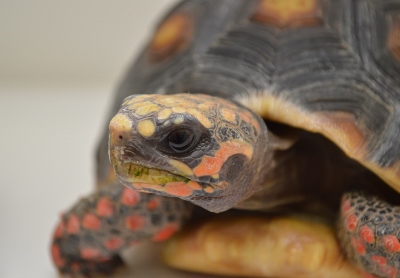
The spotlight is fading on the red-footed tortoise who was our Animal of the Month for May. We hope you followed us on Twitter @ExoticPetVets and enjoyed our tweets on these fascinating creatures. Here is a summary of our tweets in case you missed any. Did you know?:
- Red-footed tortoises (Chelonoidis carbonaria) are native to southern Central America and much of South America.
- In the wild, red-footed tortoises live in grasslands and dry forests. They can also be found at the edge of rain forests.
- As with all turtles and tortoises, the red-footed tortoise’s upper shell is called the carapace.
- The lower shell of the red-footed tortoise is called the plastron.
- The plastron and carapace are connected by bridges, which are bony structures at the tortoise’s sides.
- Tortoises can’t crawl out of their shells because the inner shell includes part of the ribs and backbone.
- Red-footed tortoises are very popular and hardy pets with the right care.
- With proper care, red-footed tortoises in captivity can have a lifespan of about 50 years.
- Red-footed tortoises require an enormous amount of dietary calcium to keep their bones and shells healthy.
- The calcium levels must be greater than the phosphorus levels in food so red-footed tortoises can absorb the calcium.
- High-calcium/low phosphorus foods for red-footed tortoises include collard greens, orange peel, rhubarb and kelp.
- Red-footed tortoises are mostly vegetarians, but they also occasionally eat insects, worms, snails and carrion.
- World Turtle Day, founded by American Tortoise Rescue (@tortoiserescue on Twitter), has been celebrated every May 23rd since 2000.
- World Turtle Day is to raise awareness and educate people about the world’s turtles and tortoises and their environments.
- Red-footed tortoises don’t have obvious external ears like we do and they can respond to low-frequency sounds.
- Red-footed tortoises rely on their other senses, such as their excellent sense of smell, to avoid predators and find food.
- Red-footed tortoises shouldn’t be over-handled as this can cause them stress and reduce their quality of life.
- Like all turtles and tortoises, red-footed tortoises can feel pressure and pain through their shells.
- CTV News Vancouver reported a British Columbia man was investigated for animal cruelty for drilling holes in his tortoise and turtle’s shells.
- Always wash your hands after handling any tortoise or turtle on concerns about the Salmonella bacterium.

